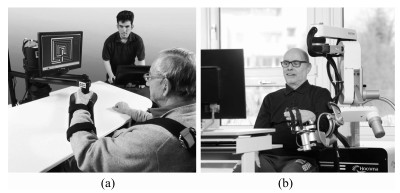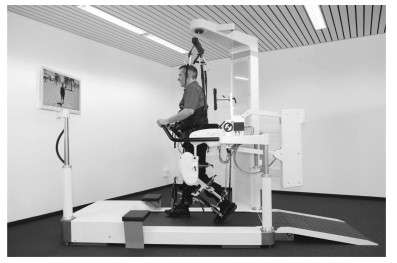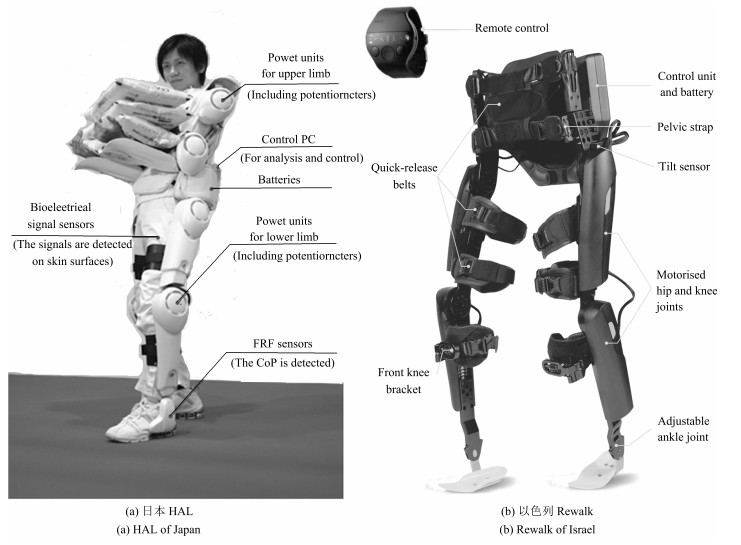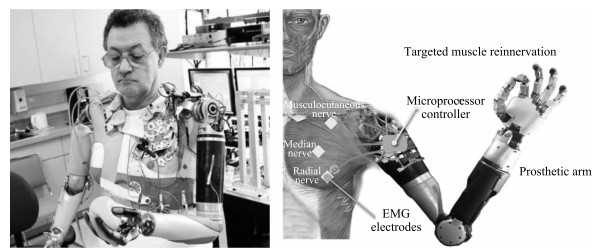|
[1]
|
侯增广, 赵新刚, 程龙, 王启宁, 王卫群.康复机器人与智能辅助系统的研究进展.自动化学报, 2016, 42(12):1765-1779 http://www.aas.net.cn/CN/abstract/abstract18966.shtmlHou Zeng-Guang, Zhao Xin-Gang, Cheng Long, Wang Qi-Ning, Wang Wei-Qun. Recent advances in rehabilitation robots and intelligent assistance systems. Acta Automatica Sinica, 2016, 42(12):1765-1779 http://www.aas.net.cn/CN/abstract/abstract18966.shtml
|
|
[2]
|
Losey D P, McDonald C G, Battaglia E, O'Malley M K. A review of intent detection, arbitration, and communication aspects of shared control for physical human-robot interaction. Applied Mechanics Reviews, 2018, 70(1):Article No. 010804 http://adsabs.harvard.edu/abs/2018ApMRv..70a0804.
|
|
[3]
|
Marchal-Crespo L, Reinkensmeyer D J. Review of control strategies for robotic movement training after neurologic injury. Journal of Neuroengineering and Rehabilitation, 2009, 6:Article No. 20 doi: 10.1186/1743-0003-6-20
|
|
[4]
|
De Santis A, Siciliano B, De Luca A, Bicchi A. An atlas of physical human-robot interaction. Mechanism and Machine Theory, 2008, 43(3):253-270 doi: 10.1016/j.mechmachtheory.2007.03.003
|
|
[5]
|
Maciejasz P, Eschweiler J, Gerlach-Hahn K, Jansen-Troy A, Leonhardt S. A survey on robotic devices for upper limb rehabilitation. Journal of Neuroengineering and Rehabilitation, 2014, 11:Article No. 3 doi: 10.1186/1743-0003-11-3
|
|
[6]
|
Hogan N, Krebs H I, Charnnarong J, Srikrishna P, Sharon A. Mit-manus: a workstation for manual therapy and training. Ⅰ. In: Proceedings of the 1992 IEEE International Workshop on Robot and Human Communication. Tokyo, Japan: IEEE, 1992. 161-165 http://www.mendeley.com/catalog/mitmanus-workstation-manual-therapy-training-i/
|
|
[7]
|
Kwakkel G, Kollen B J, Krebs H I. Effects of robot-assisted therapy on upper limb recovery after stroke:a systematic review. Neurorehabilitation and Neural Repair, 2008, 22(2):111-121 doi: 10.1177/1545968307305457
|
|
[8]
|
Nef T, Mihelj M, Colombo G, Riener R. Armin-robot for rehabilitation of the upper extremities. In: Proceedings of the 2006 IEEE International Conference on Robotics and Automation. Orlando, FL, USA: IEEE, 2006. 3152-3157 http://www.mendeley.com/research/armin-robot-rehabilitation-upper-extremities/
|
|
[9]
|
Klamroth-Marganska V, Blanco J, Campen K, Curt A, Dietz V, Ettlin T, et al. Three-dimensional, task-specific robot therapy of the arm after stroke:a multicentre, parallel-group randomised trial. The Lancet Neurology, 2014, 13(2):159-166 http://www.sciencedirect.com/science/article/pii/S1474442213703053
|
|
[10]
|
Jezernik S, Colombo G, Keller T, Frueh H, Morari M. Robotic orthosis lokomat:a rehabilitation and research tool. Neuromodulation:Technology at the Neural Interface, 2003, 6(2):108-115 doi: 10.1046/j.1525-1403.2003.03017.x
|
|
[11]
|
Duschau-Wicke A, von Zitzewitz J, Caprez A, Lunenburger L, Riener R. Path control:a method for patient-cooperative robot-aided gait rehabilitation. IEEE Transactions on Neural Systems and Rehabilitation Engineering, 2010, 18(1):38-48 doi: 10.1109/TNSRE.2009.2033061
|
|
[12]
|
明东, 蒋晟龙, 王忠鹏, 綦宏志, 万柏坤.基于人机信息交互的助行外骨骼机器人技术进展.自动化学报, 2017, 43(7):1089-1100 http://www.aas.net.cn/CN/abstract/abstract19085.shtmlMing Dong, Jiang Sheng-Long, Wang Zhong-Peng, Qi Hong-Zhi, Wan Bai-Kun. Review of walk assistant exoskeleton technology:human-machine interaction. Acta Automatica Sinica, 2017, 43(7):1089-1100 http://www.aas.net.cn/CN/abstract/abstract19085.shtml
|
|
[13]
|
Zoss A B, Kazerooni H, Chu A. Biomechanical design of the Berkeley lower extremity exoskeleton (BLEEX). IEEE/ASME Transactions on Mechatronics, 2006, 11(2):128-138 doi: 10.1109/TMECH.2006.871087
|
|
[14]
|
Mertz L. The next generation of exoskeletons:lighter, cheaper devices are in the works. IEEE Pulse, 2012, 3(4):56-61 doi: 10.1109/MPUL.2012.2196836
|
|
[15]
|
Lee S, Sankai Y. Power assist control for leg with HAL-3 based on virtual torque and impedance adjustment. In: Proceedings of the 2002 IEEE International Conference on Systems, Man, and Cybernetics. Yasmine Hammamet, Tunisia: IEEE, 2002. 6 http://ieeexplore.ieee.org/xpls/icp.jsp?arnumber=1173329
|
|
[16]
|
Esquenazi A, Talaty M, Packel A, Saulino M. The rewalk powered exoskeleton to restore ambulatory function to individuals with thoracic-level motor-complete spinal cord injury. American Journal of Physical Medicine and Rehabilitation, 2012, 91(11):911-921 doi: 10.1097/PHM.0b013e318269d9a3
|
|
[17]
|
Wehner M, Quinlivan B, Aubin P M, Martinez-Villalpando E, Baumann M, Stirling L, et al. A lightweight soft exosuit for gait assistance. In: Proceedings of the 2013 IEEE International Conference on Robotics and Automation (ICRA). Karlsruhe, Germany: IEEE, 2013. 3362-3369 http://www.mendeley.com/catalog/lightweight-soft-exosuit-gait-assistance/
|
|
[18]
|
Asbeck A T, De Rossi S M M, Galiana I, Ding Y, Walsh C J. Stronger, smarter, softer:next-generation wearable robots. IEEE Robotics and Automation Magazine, 2014, 21(4):22-33 doi: 10.1109/MRA.2014.2360283
|
|
[19]
|
Araromi O A, Walsh C J, Wood R J. Hybrid carbon fiber-textile compliant force sensors for high-load sensing in soft exosuits. In: Proceedings of the 2017 IEEE/RSJ International Conference on Intelligent Robots and Systems (IROS). Vancouver, BC, Canada: IEEE, 2017. 1798-1803 http://ieeexplore.ieee.org/document/8205994/
|
|
[20]
|
Reiter R. Eine neue elektrokunsthand. Grenzgebiete der Medizin, 1948, 1(4):133-135
|
|
[21]
|
Kuiken T A, Li G L, Lock B A, Lipschutz R D, Miller L A, Stubblefield K A, et al. Targeted muscle reinnervation for real-time myoelectric control of multifunction artificial arms. JAMA, 2009, 301(6):619-628 doi: 10.1001/jama.2009.116
|
|
[22]
|
黄剑平, 李文庆, 杨琳, 朱明星, 朱小弟, 李楚炎等.上肢经肱骨截肢神经功能重建研究.集成技术, 2016, 5(5):30-37 http://d.old.wanfangdata.com.cn/Periodical/jcjx201605003Huang Jian-Ping, Li Wen-Qing, Yang Lin, Zhu Ming-Xing, Zhu Xiao-Di, Li Chu-Yan, et al. A pilot study of nerve function reinnervation on a transhumeral amputee. Journal of Integration Technology, 2016, 5(5):30-37 http://d.old.wanfangdata.com.cn/Periodical/jcjx201605003
|
|
[23]
|
Orendurff M S, Segal A D, Klute G K, McDowell M L, Pecoraro J A, Czerniecki J M. Gait efficiency using the c-leg. Journal of Rehabilitation Research and Development, 2006, 43(2):239-246 doi: 10.1682/JRRD.2005.06.0095
|
|
[24]
|
Lawson B E, Mitchell J, Truex D, Shultz A, Ledoux E, Goldfarb M. A robotic leg prosthesis:design, control, and implementation. IEEE Robotics and Automation Magazine, 2014, 21(4):70-81 doi: 10.1109/MRA.2014.2360303
|
|
[25]
|
Schultz A E, Kuiken T A. Neural interfaces for control of upper limb prostheses:the state of the art and future possibilities. PM & R, 2011, 3(1):55-67 http://www.sciencedirect.com/science/article/pii/S1934148210005174
|
|
[26]
|
Rebsamen B, Guan C T, Zhang H H, Wang C C, Teo C, Ang M H, et al. A brain controlled wheelchair to navigate in familiar environments. IEEE Transactions on Neural Systems and Rehabilitation Engineering, 2010, 18(6):590-598 doi: 10.1109/TNSRE.2010.2049862
|
|
[27]
|
Jiang N, Englehart K B, Parker P A. Extracting simultaneous and proportional neural control information for multiple-DOF prostheses from the surface electromyographic signal. IEEE Transactions on Biomedical Engineering, 2009, 56(4):1070-1080 doi: 10.1109/TBME.2008.2007967
|
|
[28]
|
Shen B Q, Li J F, Bai F J, Chew C M. Motion intent recognition for control of a lower extremity assistive device. In: Proceedings of the 2013 IEEE International Conference on Mechatronics and Automation (ICMA). Takamatsu, Japan: IEEE, 2013. 926-931 http://www.mendeley.com/catalog/motion-intent-recognition-control-lower-extremity-assistive-device-lead/
|
|
[29]
|
Burdet E, Milner T E. Quantization of human motions and learning of accurate movements. Biological Cybernetics, 1998, 78(4):307-318 doi: 10.1007/s004220050435
|
|
[30]
|
Negro F, Muceli S, Castronovo A M, Holobar A, Farina D. Multi-channel intramuscular and surface EMG decomposition by convolutive blind source separation. Journal of Neural Engineering, 2016, 13(2):Article No. 026027 http://www.wanfangdata.com.cn/details/detail.do?_type=perio&id=c15f5fbe316d25cde6279ab9d4cedca3
|
|
[31]
|
Hargrove L J, Englehart K, Hudgins B. A comparison of surface and intramuscular myoelectric signal classification. IEEE Transactions on Biomedical Engineering, 2007, 54(5):847-853 doi: 10.1109/TBME.2006.889192
|
|
[32]
|
Vallery H, Veneman J, van Asseldonk E, Ekkelenkamp R, Buss M, van der Kooij H. Compliant actuation of rehabilitation robots. IEEE Robotics and Automation Magazine, 2008, 15(3):60-69 doi: 10.1109/MRA.2008.927689
|
|
[33]
|
Wolf S, Grioli G, Eiberger O, Friedl W, Grebenstein M, Höppner H, et al. Variable stiffness actuators:review on design and components. IEEE/ASME Transactions on Mechatronics, 2016, 21(5):2418-2430 doi: 10.1109/TMECH.2015.2501019
|
|
[34]
|
Engemann D A, Gramfort A. Automated model selection in covariance estimation and spatial whitening of MEG and EEG signals. NeuroImage, 2015, 108:328-342 doi: 10.1016/j.neuroimage.2014.12.040
|
|
[35]
|
Fougner A, Scheme E, Chan A D C, Englehart K, Stavdahl Ø. Resolving the limb position effect in myoelectric pattern recognition. IEEE Transactions on Neural Systems and Rehabilitation Engineering, 2011, 19(6):644-651 doi: 10.1109/TNSRE.2011.2163529
|
|
[36]
|
Peng L, Hou Z G, Chen Y X, Wang W Q, Tong L N, Li P F. Combined use of sEMG and accelerometer in hand motion classification considering forearm rotation. In: Proceedings of the 35th Annual International Conference of the IEEE Engineering in Medicine and Biology Society (EMBC). Osaka, Japan: IEEE, 2013. 4227-4230 http://www.mendeley.com/research/combined-semg-accelerometer-hand-motion-classification-considering-forearm-rotation/
|
|
[37]
|
Cé E, Rampichini S, Monti E, Venturelli M, Limonta E, Esposito F. Changes in the electromechanical delay components during a fatiguing stimulation in human skeletal muscle:an EMG, MMG and force combined approach. European Journal of Applied Physiology, 2017, 117(1):95-107 doi: 10.1007/s00421-016-3502-z
|
|
[38]
|
Zardoshti-Kermani M, Wheeler B C, Badie K, Hashemi R M. EMG feature evaluation for movement control of upper extremity prostheses. IEEE Transactions on Rehabilitation Engineering, 1995, 3(4):324-333 doi: 10.1109/86.481972
|
|
[39]
|
Boostani R, Moradi M H. Evaluation of the forearm EMG signal features for the control of a prosthetic hand. Physiological Measurement, 2003, 24(2):309-319 doi: 10.1088/0967-3334/24/2/307
|
|
[40]
|
Nazmi N, Rahman M A A, Yamamoto S I, Ahmad S A, Zamzuri H, Mazlan S A. A review of classification techniques of EMG signals during isotonic and isometric contractions. Sensors, 2016, 16(8):Article No. 1304 doi: 10.3390/s16081304
|
|
[41]
|
Shao Q, Bassett D N, Manal K, Buchanan T S. An EMG-driven model to estimate muscle forces and joint moments in stroke patients. Computers in Biology and Medicine, 2009, 39(12):1083-1088 doi: 10.1016/j.compbiomed.2009.09.002
|
|
[42]
|
Buchanan T S, Lloyd D G, Manal K, Besier T F. Neuromusculoskeletal modeling:estimation of muscle forces and joint moments and movements from measurements of neural command. Journal of Applied Biomechanics, 2004, 20(4):367-395 doi: 10.1123/jab.20.4.367
|
|
[43]
|
Lloyd D G, Besier T F. An EMG-driven musculoskeletal model to estimate muscle forces and knee joint moments in vivo. Journal of Biomechanics, 2003, 36(6):765-776 doi: 10.1016/S0021-9290(03)00010-1
|
|
[44]
|
Kiguchi K, Hayashi Y. An EMG-based control for an upper-limb power-assist exoskeleton robot. IEEE Transactions on Systems, Man, and Cybernetics, Part B (Cybernetics), 2012, 42(4):1064-1071 doi: 10.1109/TSMCB.2012.2185843
|
|
[45]
|
Kawamoto H, Sankai Y. Comfortable power assist control method for walking aid by HAL-3. In: Proceedings of the 2002 IEEE International Conference on Systems, Man, and Cybernetics. Yasmine Hammamet, Tunisia: IEEE, 2002. http://ieeexplore.ieee.org/xpls/icp.jsp?arnumber=1173328
|
|
[46]
|
彭亮, 侯增广, 王卫群.康复机器人的同步主动交互控制与实现.自动化学报, 2015, 41(11):1837-1846 http://www.aas.net.cn/CN/abstract/abstract18759.shtmlPeng Liang, Hou Zeng-Guang, Wang Wei-Qun. Synchronous active interaction control and its implementation for a rehabilitation robot. Acta Automatica Sinica, 2015, 41(11):1837-1846 http://www.aas.net.cn/CN/abstract/abstract18759.shtml
|
|
[47]
|
Yatsenko D, McDonnall D, Guillory K S. Simultaneous, proportional, multi-axis prosthesis control using multichannel surface EMG. In: Proceedings of the 29th Annual International Conference of the IEEE Engineering in Medicine and Biology Society. Lyon, France: IEEE, 2007. 6133-6136 http://www.ncbi.nlm.nih.gov/pubmed/18003415/
|
|
[48]
|
Lenzi T, De Rossi S M M, Vitiello N, Carrozza M C. Intention-based EMG control for powered exoskeletons. IEEE Transactions on Biomedical Engineering, 2012, 59(8):2180-2190 doi: 10.1109/TBME.2012.2198821
|
|
[49]
|
Ge S S, Li Y A, He H S. Neural-network-based human intention estimation for physical human-robot interaction. In: Proceedings of the 8th International Conference on Ubiquitous Robots and Ambient Intelligence (URAI). Incheon, South Korea: IEEE, 2011. 390-395 http://www.mendeley.com/catalog/neuralnetworkbased-human-intention-estimation-physical-humanrobot-interaction/
|
|
[50]
|
Hogan N. Impedance control:an approach to manipulation:Part I:theory, Part Ⅱ:implementation, Part Ⅲ:applications. Journal of Dynamic Systems, Measurement, and Control, 1985, 107:1-24 doi: 10.1115/1.3140702
|
|
[51]
|
Zlatnik D, Steiner B, Schweitzer G. Finite-state control of a trans-femoral (TF) prosthesis. IEEE Transactions on Control Systems Technology, 2002, 10(3):408-420 doi: 10.1109/87.998030
|
|
[52]
|
Modares H, Ranatunga I, Lewis F L, Popa D O. Optimized assistive human-robot interaction using reinforcement learning. IEEE Transactions on Cybernetics, 2016, 46(3):655-667 doi: 10.1109/TCYB.2015.2412554
|
|
[53]
|
Wen Y, Si J, Gao X, Huang S, Huang H H. A new powered lower limb prosthesis control framework based on adaptive dynamic programming. IEEE Transactions on Neural Networks and Learning Systems, 2017, 28(9):2215-2220 http://europepmc.org/abstract/MED/27416607
|
|
[54]
|
Schaechter J D. Motor rehabilitation and brain plasticity after hemiparetic stroke. Progress in Neurobiology, 2004, 73(1):61-72 doi: 10.1016/j.pneurobio.2004.04.001
|
|
[55]
|
Krakauer J W. Motor learning:its relevance to stroke recovery and neurorehabilitation. Current Opinion in Neurology, 2006, 19(1):84-90 doi: 10.1097/01.wco.0000200544.29915.cc
|
|
[56]
|
Carr J H, Shepherd R B. Stroke Rehabilitation: Guidelines for Exercise and Training to Optimize Motor Skill. Butterworth-Heinemann Medical, Oxford, UK, 2003. Stroke Rehabilitation: Guidelines for Exercise and Training to Optimize Motor Skill
|
|
[57]
|
Levin M F, Weiss P L, Keshner E A. Emergence of virtual reality as a tool for upper limb rehabilitation:incorporation of motor control and motor learning principles. Physical Therapy, 2015, 95(3):415-425 doi: 10.2522/ptj.20130579
|
|
[58]
|
胡进, 侯增广, 陈翼雄, 张峰, 王卫群.下肢康复机器人及其交互控制方法.自动化学报, 2014, 40(11):2377-2390 http://www.aas.net.cn/CN/abstract/abstract18514.shtmlHu Jin, Hou Zeng-Guang, Chen Yi-Xiong, Zhang Feng, Wang Wei-Qun. Lower limb rehabilitation robots and interactive control methods. Acta Automatica Sinica, 2014, 40(11):2377-2390 http://www.aas.net.cn/CN/abstract/abstract18514.shtml
|
|
[59]
|
Basteris A, Nijenhuis S M, Stienen A H A, Buurke J H, Prange G B, Amirabdollahian F. Training modalities in robot-mediated upper limb rehabilitation in stroke:a framework for classification based on a systematic review. Journal of Neuroengineering and Rehabilitation, 2014, 11:Article No. 111 doi: 10.1186/1743-0003-11-111
|
|
[60]
|
Lo A C, Guarino P D, Richards L G, Haselkorn J K, Wittenberg G F, Federman D G, et al. Robot-assisted therapy for long-term upper-limb impairment after stroke. New England Journal of Medicine, 2010, 362(19):1772-1783 doi: 10.1056/NEJMoa0911341
|
|
[61]
|
Reinkensmeyer D J, Wolbrecht E, Bobrow J. A computational model of human-robot load sharing during robot-assisted arm movement training after stroke. In: Proceedings of the 29th Annual International Conference of the IEEE Engineering in Medicine and Biology Society. Lyon, France: IEEE, 2007. 4019-4023 http://www.ncbi.nlm.nih.gov/pubmed/18002881
|
|
[62]
|
Cai L L, Fong A J, Liang Y Q, Burdick J, Edgerton V R. Assist-as-needed training paradigms for robotic rehabilitation of spinal cord injuries. In: Proceedings of the 2006 IEEE International Conference on Robotics and Automation. Orlando, FL, USA: IEEE, 2006. 3504-3511 ssist-as-needed training paradigms for robotic rehabilitation of spinal cord injuries.
|
|
[63]
|
Krebs H I, Palazzolo J J, Dipietro L, Ferraro M, Krol J, Rannekleiv K, et al. Rehabilitation robotics:performance-based progressive robot-assisted therapy. Autonomous Robots, 2003, 15(1):7-20 doi: 10.1023/A:1024494031121
|
|
[64]
|
Wolbrecht E T, Chan V, Reinkensmeyer D J, Bobrow J E. Optimizing compliant, model-based robotic assistance to promote neurorehabilitation. IEEE Transactions on Neural Systems and Rehabilitation Engineering, 2008, 16(3):286-297 doi: 10.1109/TNSRE.2008.918389
|
|
[65]
|
Pehlivan A U, Losey D P, O'Malley M K. Minimal assist-as-needed controller for upper limb robotic rehabilitation. IEEE Transactions on Robotics, 2016, 32(1):113-124 http://www.wanfangdata.com.cn/details/detail.do?_type=perio&id=7dba74b5b9256a157f209f2c28b5611a
|





 下载:
下载:






